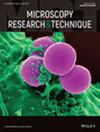Unveiling thrips morphology: A comparative analysis of microscopy-based ultrastructural, morphological, and molecular characterization of Thrips tabaci and Thrips parvispinus in onion
Abstract
The present study unveils the intricate details on the morphology of thrips through optical, field emission scanning electron microscopy (FE-SEM) and mitochondrial cytochrome oxidase I gene-based molecular identification tools. The variation in the morphological characters namely, antennae (seven-segmented with forked sensorium on third, fourth segments), ctenidia (paired ctenidia were present in 5th–8th abdominal segments laterally), pronotum (two pairs of posteroangular setae) were observed in both Thrips tabaci and Thrips parvispinus, respectively. Similarly, ocelli color (brown and red colored), ocellar setae (two and three pairs of ocellar setae on the head of T. tabaci and T. parvispinus, respectively. Irregular reticulate striations on metascutum and medial striations are present in the metanotum of T. parvispinus; forewings with 6 distal setae in the first vein and 15 distal setae in the second vein in T. tabaci and forewings of T. parvispinus with complete rows of setae in the first and second vein in T. parvispinus; abdomen with median dorsal setae present in the tergite of T. tabaci and presence of 6–12 discal setae in sternites III–VI segments, absence of discal setae on sternites II and VII in T. parvispinus were observed, respectively. Further, FE-SEM studies revealed that similar type of sensilla namely, sensilla basiconica (SBI, SBII, SBIII), sensilla chaetica (SChI, SChII), sensilla trichodea (ST), sensilla campaniformia (SCa), and sensilla cavity (SCav) were recorded in both the species and variations were observed in length of above sensilla of T. tabaci and T. parvispinus. Additionally, Bohm bristles (Bb) and microtrichia (Mt) on the antennal surface contributed to a comprehensive understanding of their ultrastructural features. The molecular characterization revealed a single ~450 bp nucleotide fragment with over 98% similarity for the confirmation of T. tabaci and T. parvispinus in concurrence with NCBI data.
Research Highlights
- Microscopy-based morphological and ultrastructural characterization of Thrips tabaci Lindeman and Thrips parvispinus Karny.


 求助内容:
求助内容: 应助结果提醒方式:
应助结果提醒方式:


